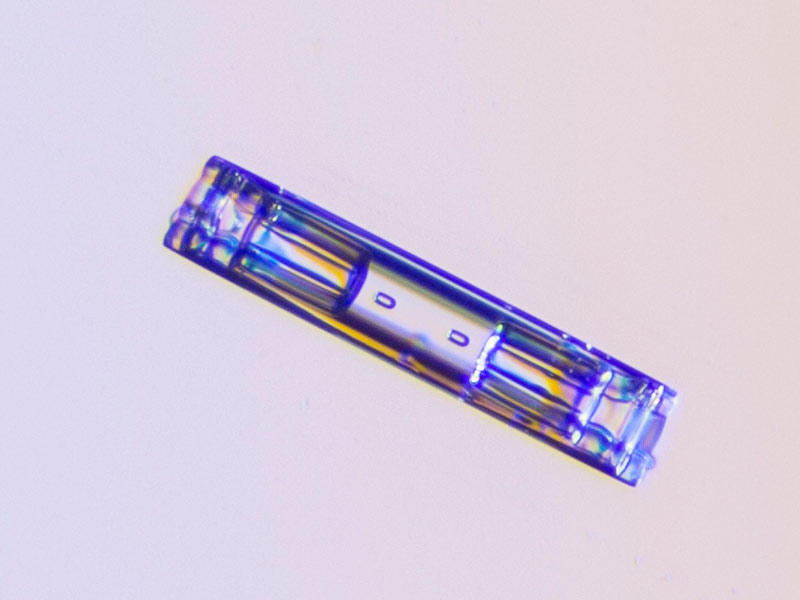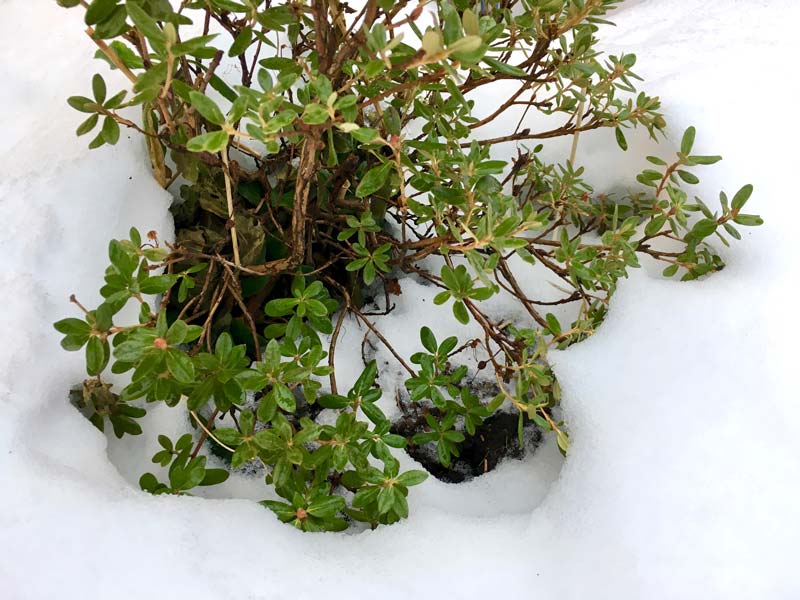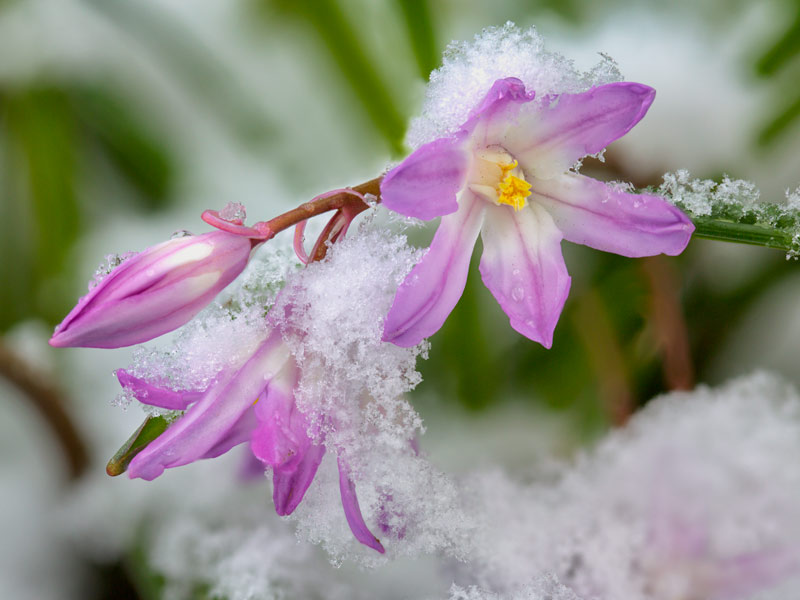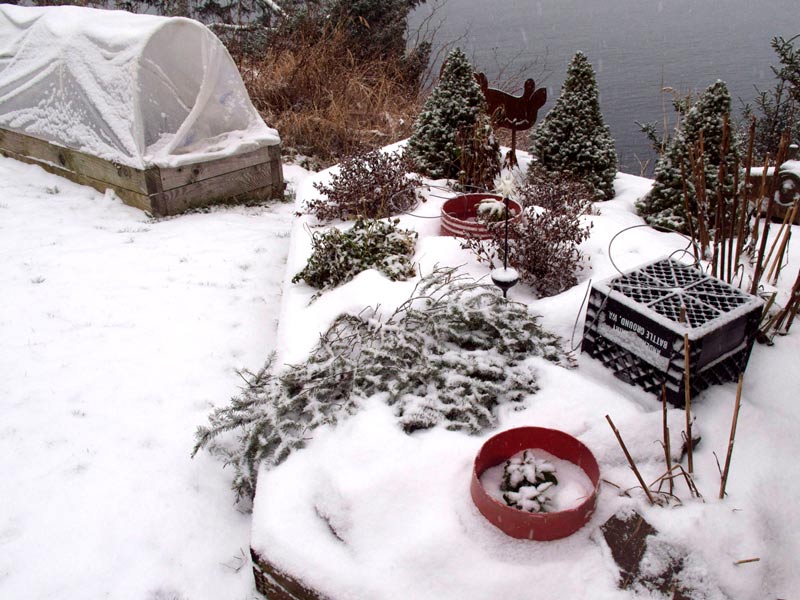It’s snowing. Big fluffy flakes. You start to worry that your shrubs and winter flowering plants might suffer. The good news: Snow benefits plants. But it can also spell trouble. Here’s a comprehensive list to see how snow helps and harms plants. Plus steps you can take to minimize damage. As a bonus, I’ll share my all-time favorite tips for protecting plants. So, let’s dig in…
To help you navigate this list of tips, I put together a table of contents:
Benefits of snow: A gardener’s dozen
How snow damages plants, shrubs, trees
How to protect plants from snow and cold
Books, websites and other resources
Benefits of snow: A gardener’s dozen
[perfectpullquote align=”full” bordertop=”false” cite=”” link=”” color=”” class=”” size=””]There’s a saying, “A good winter with snow makes all the plants grow.”[/perfectpullquote]
Snowflakes: Nature’s frost blanket
Believe it or not, temperatures under a layer of snow are usually warmer than the outside air. All thanks to the structure of snowflakes. Inside each crystal are hundreds of tiny air pockets encased in ice. Even larger air pockets form when snowflakes heap together on the ground. The result is a fluffy, down quilt that insulates the ground. Without snow, prolonged periods of cold can spell trouble. Roots are unable to take up water which means plants, including your lawn, can die from dehydration.
See this photo below? What do you suppose it is?
If you guessed “something small,” you are partially right.
It’s a tiny snow crystal. Amazing, isn’t it? I took this picture while photographing bigger flakes like the next picture. At first, I didn’t think it was anything special. Until I started writing this article…

Like a flashlight
Snow’s whiteness reflects a certain amount of sunlight. But much of the light penetrates snow like a giant flashlight. Which means plants can continue photosynthesis through the winter.
Fertilizer from the sky
Something magic happens when it snows. As snowflakes tumble downward, sulfur and nitrogen compounds cling to the crystals. Then, when the snow melts, these elements release into the soil where plants absorb them.

[perfectpullquote align=”full” bordertop=”false” cite=”” link=”” color=”” class=”” size=””]Did you know? A snowflake’s journey from the upper atmosphere to the ground takes about 20 minutes.[/perfectpullquote]
If you think the snowflake above is pretty cool, you might also enjoy my video, “Real Snowflakes Set to Relaxing Music.”
Eases freeze-thaw damage
Freeze-thaw periods can be deadly to plants. They cause water in the soil to expand and contract. Roots break, daffodil bulbs turn to mush, even launching out of the soil. A blanket of snow saves the day by softening the blows of extreme temperature swings.
/////
ATTENTION GARDENERS! If your compost isn’t working as it should, take my 60-second composting quiz.
/////
Doubles as a windbreaker
Snow not only insulates plants from sub-zero temps, but it also shelters them from fierce winds. Nature’s windbreaker. Icy gales suck moisture from leaves, stems, and roots.
A quilt for containers
Planters create miniature gardens to grow flowers, herbs, and veggies. , pots and containers shrouded with snow are less apt to crack and split. Bottom line: More plants and shrubs survive ‘til spring.
Learn a lesson from trees
The next time it snows, go for a walk in the woods. Observe. Here, let me help. In a dense coniferous forest of cedar, pine, or spruce, 75 percent of a heavy snowfall collects on tree tops. Which means, not much snow reaches the ground. No snow. No insulation. The ground can remain frozen well into spring.
When snow falls in a deciduous forest of maples though, most of it collects on the leaves and soil below. Snow… Insulation. You got it. The ground remains warmer over the winter.
I bet you can guess that the same thing happens in the garden. Let’s say you planted tulip bulbs and primroses under a spruce tree. Uh, oh. The ground is bare of snow. Needless to say, the tulips didn’t bloom and the primroses remained scrawny.
Drip, drip, drip
Plants need moisture. Rain, fog, hail, snow, sprinkler. Compared to rain, snow has a gentle touch. It’s true. When snow melts, it releases moisture drip by drip. At the same time, snow improves soil tilth or texture. And to some degree, so does freezing and thawing. Much like the burrowing action of earthworms, bacteria, and fungi.
Exposing creatures of the night
What creatures tip-toe around your garden at night? What part of the yard thaws out first in spring? Snow reveals mysteries while you sleep. Deer tracks, mice prints.

Exposing microclimates
First, let’s explore what a microclimate is… I’ll give it a try. A microclimate is a pocket zone within a general climate zone that has its own climate. Make sense?
Think of your yard. The garden by the front door might be warmer than the rest of the yard. You might be wondering why I mention microclimates. I’ll give you an example: If you plant a warm-loving shrub in a spot where snow lingers, it suffers. Observing how snow collects and later melts in microclimates offers valuable clues. Observe how the wind deposits new snow and shapes existing drifts. Notice where sunlight melts snow first and last.
The perfect bird feeder
Brown seeds stand out against the white of snow for birds and small animal to find.
God bless dirty snow!
Ever noticed how snow turns to slush faster where the road grader created snow berms? That’s because when snow becomes dirty it absorbs more sunlight, heats, and melts.
God bless white snow!
Winters in Kodiak are dark. Our shortest day is 6.5 hours. I can hardly wait for the first snowfall! It brightens everything, creating peace and stillness which lifts everyone’s mood. Especially Dan, who runs the local tire shop.
In Japan, snow is revered. Stone lanterns called Yukimi are set out as snow-viewing accents. As for snowflakes. When they settle on branches they become Sekka, or snow flowers. Google Sekka.
Speaking of Japan, here is a charming video: 1st Time Seeing Snow! – Japan’s Winter Wonderland
Christmas carrots
Every year, I gamble with my root crops. I leave them in the ground as long as possible. Snow insulates the ground, right? It buys time to dig leeks, beets, kale, and carrots. Sometimes I win. Sometimes I lose.
How snow damages plants, shrubs, trees
You’ve seen trees and shrubs damaged by heavy snowfalls, right? Too much snow also blocks sunlight. This prevents snow warming from below. This can delay the emerging of bulbs and perennials in spring.
Enabling slugs
It’s true that a blanket of snow protects your precious shrubs, trees, and perennials. But did you know it also shields nasty pests and diseases? Be aware. Slugs, snails, molds, even aphids can overwinter quite nicely in a snow condo.
Enabling animals
Like a step-stool, snow gives rabbits, deer, and other critters a leg-up to reach higher branches. Mice, voles, and rats tunnel in snow and gnaw on tender shoots. Snow sometimes means trouble for the animals, too. Ever seen moose antlers decorated with Christmas lights tangled in their antlers? Scooped up while chewing on willow branches.
Deadly pools of ice
When the snow melts in the spring, it provides much-needed water to winter-thirsty plants. “But snow becomes a horror to plants when it thaws too quickly and forms ice pools around plants,” says Master Gardener Deb Blaylock of Palmer, Alaska. “The freezing and thawing of these pools are deadly to most plants.”
Which brings us to problem-solving:
How to protect plants from snow and cold
Improve soil drainage
As Deb mentioned above, standing pools of icy water is a problem. The solution? Improve soil drainage. Stop using chemical fertilizers. Work in compost, well-rotted manure, leaf mulch, bark chips, sand, sawdust, straw, or shredded seaweed. Healthy soil grows healthy plants. This is the bedrock of organic gardening.
A weighty problem
Snow might be a great insulator, but too much of a good thing can break branches and trunks. Clear snow from greenhouses and sheds. I’ve watched with dismay as a slab of snow slid down my greenhouse roof. Swoosh. It pancaked a favorite rhododendron
And what about your lawn?
Lawns covered by a deep layer of snow can cause snow molds. Circular patches polka-dot your lawn. Solution: Improve your soil. You might enjoy my article about the best lawn fertilizer.
Tap, tap, tap trees, trees, please
As a child, I loved to traipse around the winter garden with a broomstick, tapping snow off plants. Bamboo especially. A quick slap sent a shudder through the stalks. They sat upright, dislodging the snow and showering me from head to toe.
Choose your plants wisely
Do you think I can grow bananas in Alaska? In my dreams. It’s tempting to grow exotic plants in cold climates. But in the long run, such gambles are a waste of time, money, and energy. Select hardy plants that are suitable for your micro-climate. Tip: Golden and variegated plants are often more tender.

Avoid chemical fertilizers
High nitrogen fertilizers such as Miracle-Gro encourage the growth of spongy, weak leaves. I call them couch-potato plants. Limp, over-fed leaves are more susceptible to cold damage. Solution: Ditch the chemicals. Stick with organic mulch and compost.
Container care
Snow insulates containers. True. But there’s one small catch: Snow might not be enough to prevent cracking and splitting. So, choose containers that are frost-proof. Wood, plastic, mesh. Avoid terra-cotta. Or move containers out of the weather and into a shed, greenhouse or the leeward side of a building. Wrap with burlap, bubble-wrap to prevent damage to pot or plant.
And now, my favorite tips…
Before the snow flies, I place spruce branches around the garden. Over blue poppies, daffodil bulbs, bleeding hearts, and underneath rhododendrons and currant bushes. These giant, evergreen “hands” provide the ideal layer of protection. Especially during snow-free winters. Ideal because they allow life-giving light, air, and moisture to circulate. Cool climate gardening 101.

To wrap things up, snow is one of nature’s best plant covers for winter. And it extends a break from our garden chores. Time for tea and reflection.
And hey, you’ll love this: If you didn’t gather up your dead broccoli stalks, no worries. With snow, your neighbors will never know!
Thanks for visiting!

P.S. Do you have a favorite snow story? Share it in a comment below…
Books, websites and other resources
Learn how they do it in Alaska: Matanuska-Susitna Master Gardeners Association
From my blog: What is the best lawn fertilizer? Hint: It’s the one simple tip to enjoy a lawn that’s green, easy to maintain, tolerant of extreme weather, and safe for kids and pets. Bottom line: It’s the best lawn fertilizer that money can’t buy.
Book: The Bountiful Container, by McGee and Stuckey.
+ + + + + + + + + + + +
Marion Owen is a “Jill of all trades,” with 30 years of experience as a teacher and columnist. She’s on a mission to help busy people enhance their daily lives, condensing topics such as photography, cooking, and organic gardening into bite-size pieces. Get her free 4-page “In Good Light: Photo Tips for Busy People” and feel newly recharged when taking pictures.
These were great tips thank you.
Thank you for writing such a nice article
What a useful article, and so easy to understand! Thanks!
Pingback: What Happens to Plants in the Winter? - Bully Tools, Inc.